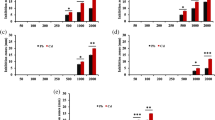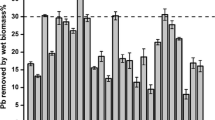Abstract
Some probiotic strains, such as Lactobacillus spp., are options for the removal of heavy metals from food, water and soil. Although copper or zinc are essential for use in many biochemical processes, they are toxic at high concentrations. The purpose of the current study was to evaluate two Lactobacillus strains for their application in the bioremediation of copper and zinc from aqueous solution. The biomass of Lactobacillus fermentum and Lactobacillus plantarum were treated with different concentrations of copper or zinc (0–200 mM). Minimum inhibitory concentration, biosorption capacity and kinetic biosorption behavior were determined. The results showed rapid biosorption of both metals and both species, removed zinc ions more efficient than copper. The highest removal rate of zinc reached 84% for the L.fermentum. Moreover, Freundlich and Langmuir model indicated that L.fermentum showed a higher capability to biosorp heavy metal compared to L.plantarum. It was concluded that L.fermentum biomass, a widely available and highly efficient biosorbant, could be applied for zinc or copper bioremediation from the aquatic environment.




Similar content being viewed by others
References
Abbas SH, Ismail IM, Mostafa TM, Sulaymon AH (2014) Biosorption of heavy metals: a review J Chem. Sci Technol 3(4):74–102
Al-momani FA, Massadeh AM, Hadad YA (2007) Uptake of zinc and copper by halophilic bacteria isolated from the dead sea shore. Jordan Biol Trace Elem Res 115:291
Ameen FA, Hamdan AH, El-Naggar MY (2020) Assessment of the heavy metal bioremediation efficiency of the novel marine lactic acid bacterium, Lactobacillus plantarum MF042018. Sci Rep 10:314
Babaei H, Kheirandish R, Ebrahimi L (2012) The effects of copper toxicity on histopathological and morphometrical changes of the rat testes. Asian Pac J Trop Biomed 2:S1615–1619
Babak L, Šupinova P, Zichova M, Burdychova R, Vitova E (2012) Biosorption of Cu2+, Zn2+ and Pb by thermophilic bacteria—effect of biomass concentration on biosorption capacity. Acta Univ Agric Silvic Mendel Brun 60:9–18
Bhakta JN, Ohnishi K, Munekage Y, Iwasaki K, Wei MQ (2012) Characterization of lactic acid bacteria-based probiotics as potential heavy metal sorbents. J Appl Microbiol 112:1193–1206
Chen XC, Wang YP, Lin Q, Shi JY, WX W, Chen YX (2005) Biosorption of copper(II) and zinc(II) from aqueous solution by Pseudomonas putida CZ1. Colloids Surf B 46(2):101–107
Dadrasnia A, Chuan W, Shahsavari KS, Azirun MS, Ismail S (2015) Biosorption potential of Bacillus salmalaya Strain 139SI for removal of Cr(VI) from aqueous solution. Int J Environ Res Public Health 12(12):15321–15338
Dixit R, Malaviya D, Pandiyan K, Singh UB, Sahu A, Shukla R et al (2015) Bioremediation of heavy metals from soil and aquatic environment: an overview of principles and criteria of fundamental processes. Sustainability 7(2):2189–2212
Durve A, Naphade S, Bhot A, Varghese J, Chandra N (2013) Quantitative evaluation of heavy metal bioac Cu2+mulation by microbes. J Microbiol Biotechnol Res 3:21–32
Gadd GM (2010) Metals, minerals and microbes: geo microbiology and bioremediation. Microbiology 156:609–643
Gheorghe S, Stoica C, Vasile GG, Nita-Lazar M, Stanes E (2017) Metals toxic effects in aquatic ecosystems: modulators of water quality. IntechOpen. https://doi.org/10.5772/65744
Gürses A, Bayrakçeken S, Gülabolu S (1992) Adsorption of o-cresol from aqueous solution on coal. Colloids Surf 64:7–13
Halttunen T, Salminen S, Tahvonen R (2007) Rapid removal of lead and cadmium from water by specific lactic acid bacteria. Int J Food Microbiol 114(1):30–35
Huang Z, Pan X-D, Wu P-G, Han J-L, Chen Q (2013) Health risk assessment of heavy metals in rice to the population in Zhejiang China. PLoS ONE 8(9):e75007. https://doi.org/10.1371/journal.pone.0075007
Huët MAL, Puchooa D (2017) Bioremediation of heavy metals from aquatic environment through microbial processes: a potential role for probiotics. J App Biol Biotech 5(6):14–23
Jiang CY, Sheng XF, Qian M, Wang QY (2008) Isolation and characterization of a heavy metal-resistant Burkholderia spp from heavy metal-contaminated paddy field soil and its potential in promoting plant growth and heavy metal acCu2+mulation in metal-polluted soil. Chemosphere 72(2):157–164
Kirillova AV, Danilushkina AA, Irisov DS, Bruslik NL, Fakhrullin RF, Zakharov YA, Bukhmin VS, Yarullina DR (2017) Assessment of resistance and bioremediation Ability of Lactobacillus strains to lead and cadmium. Int J Microbiol 2017:7
Khodaverdiloo H, Samadi A (2011) Batch equilibrium study on sorption, desorption, and immobilisation of cadmium in some semi-arid zone soils as affected by soil properties. Soil Res 49:444–454
König H, Unden G, Fröhlich J (2009) Biology of microorganisms on grapes, in must and wine. Springer-Verlag, Heidelberg
Leal PP, Hurd CL, Sander SG, Kortner B (2016) Exposure to chronic and high dissolved copper concentrations impede meiospore development of the kelps Macrocystis pyrifera and Undaria pinnatifida (Ochrophyta). Phycologia 55:12–20
Lefebvre DD, Edwards CD (2010) Decontaminating heavy metals using photosynthetic microbes. In: Shah V (ed) Emerging environmental technologies. Springer, New York
Leonardi A, Zanoni S, Lucia M, Amaretti A, Raimondi S, Rossi M (2013) Zinc uptake by lactic acid bacteria. ISRN Biotechnol. https://doi.org/10.5402/2013/312917
Lima de Silva AA, De Carvalho MA, De Souza SA, Dias PM, De Silva Filho RG, De Meirelles Saramago CS, De Melo Bento CA, Hofer E (2012) Heavy metal tolerance (Cr, Ag and Hg) in bacteria isolated from sewage. Braz J Microbiol 43(4):1620–1631
McDevitt CA, Ogunniyi AD, Valkov E, Lawrence MC, Kobe B, McEwan AG, Paton JC (2011) A molecular mechanism for bacterial susceptibility to zinc. PLoS Pathog 7(11):e1002357. https://doi.org/10.1371/journal.ppat.1002357
McKay G, Bino MJ, Altamemi AR (1985) The adsorption of various pollutants from aqueous solutions on to activated carbon. Water Res 19(4):491–495
Oves M, Khan MS, Zaidi A (2013) Biosorption of heavy metals by Bacillus thuringiensis strain OSM29 originating from industrial effluent contaminated north Indian soil. Saudi J Biol Sci 20(2):121–129. https://doi.org/10.1016/j.sjbs.2012.11.006
Plum LM, Rink L, Haase H (2010) The essential toxin: impact of zinc on human health. Int J Environ Res Public Health 7:1342–1365. https://doi.org/10.3390/ijerph7041342
Samarth DP, Chandekar CJ, Bhadekar RK (2012) Biosorption of heavy metals from aqueous solution using Bacillus licheniformis. Int J Pure Appl Sci Technol 10(2):12–19
Sandu C, Farkas A, Musa-Iacob R, Ionica D, Parpala L, Zinevici V, Dobre D, Radu M et al (2008) Monitoring pollution in river mures, romania, part i: the limitation of traditional methods and community response. Large Rivers 18(1–2):91–106
Schut S, Zauner S, Hampel G, König H, Claus H (2011) Biosorption of copper by wine-relevant lactobacilli. Int J Food Microbiol 145(1):126–131
Shamim S (2018) Biosorption of heavy metals, biosorption, jan derco and branislav vrana. IntechOpen. https://doi.org/10.5772/intechopen.72099
Tafakori V, Zadmard R, Tabandeh F, Amoozegar MA, Ahmadian G (2017) Equilibrium isotherm, kinetic modeling, optimization, and characterization studies of cadmium adsorption by surface-engineered escherichia coli. Iran Biomed J 21(6):380–391
Wang J, Chen C (2009) Biosrbents for heavy metals removal and their future. Biotechnol Adv 27:195–225
Zou X, Weng M, Ji X, Guo R, Zheng W, Yao W (2017) Comparison of antibiotic resistance and copper tolerance of Enterococcus spp. and Lactobacillus spp. isolated from piglets before and after weaning. J Microbiol 55:703–710
Acknowledgement
Financial support for this work was provided by Research Council of Roudehen Branch, Islamic Azad University, Roudehen, Iran.
Funding
This research received no specific grant from any funding agency in the academic or commercial sectors.
Author information
Authors and Affiliations
Contributions
SHMK: performed experiments. NHS: Designed and performed experiments, analyzed data and wrote the paper.
Corresponding author
Ethics declarations
Conflict of interest
The author declares that there is no conflict of interest regarding the publication of this article.
Additional information
Communicated by Erko Stackebrandt.
Publisher's Note
Springer Nature remains neutral with regard to jurisdictional claims in published maps and institutional affiliations.
Rights and permissions
About this article
Cite this article
Hasr Moradi Kargar, S., Hadizadeh Shirazi, N. Lactobacillus fermentum and Lactobacillus plantarum bioremediation ability assessment for copper and zinc. Arch Microbiol 202, 1957–1963 (2020). https://doi.org/10.1007/s00203-020-01916-w
Received:
Revised:
Accepted:
Published:
Issue Date:
DOI: https://doi.org/10.1007/s00203-020-01916-w




